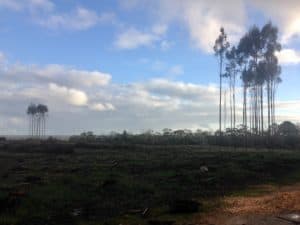Share this article
JWM: Tree plantations provide koala habitat — for now
Tree plantations could provide suitable temporary habitat for koalas (Phascolarctos cinereus) in southwestern Australia, since the animals move around plantation-dominated landscape the same way as they would in other spaces.
“There’s definitely massive value for plantations in this region and other regions in Australia,” said TWS member Kita Ashman, a PhD student at Australia’s Deakin University and lead author of a study in the Journal of Wildlife Management. “They can offer complementary habitat for wildlife.”
But those plantations eventually have to be harvested, meaning they don’t provide permanent habitat for the koalas. “When those plantations are cut down, that makes a massive disturbance for koalas living in those plantations,” Ashman said.
Southwestern Australia includes a mosaic of native forest, cleared pasture for livestock and tree plantations. The region was largely cleared for pasture in the 1900s, Ashman said, but plantation cover has increased throughout the 2000s with the establishment of a national carbon offsetting policy. For koalas, eucalyptus plantations can actually be “high quality habitat,” she said, “because it’s all a single species that they can eat.”
Ashman and her team studied koala behavior in two sites in southwest Australia: one dominated by livestock pasture and another by blue gum (Eucalyptus globulus) plantations. The two areas had similar amounts of native vegetation, which appears in strips and chunks along roadsides and on private properties. The researchers captured 20 koalas in each site and fitted them with GPS collars that recorded eight months of location data. They used the data to compare the animals’ ranging behavior between the two areas.

Landscapes in southwestern Australia are mosaics of native vegetation, tree plantations and cleared agricultural land.
Credit: Kita Ashman
It turned out that koalas moved around the landscape about the same in both sites.
“We didn’t find any differences in any of the habitat use measures that we looked at across both of the landscapes,” Ashman said. Koalas in both landscapes had similar home range sizes and their core areas — the places where they spent the majority of their time — were similarly sized and similarly spaced apart.
While the team found that the koalas did visit plantations as complementary habitat, the marsupials still used native vegetation more.
“We were surprised that quite a number of the individual koalas that we caught in the plantation landscape actually spent most of their time in native vegetation,” Ashman said. “They seem to duck in and out rather than spend huge chunks of time in the plantation.” However, all the koalas in her study were originally captured in native vegetation, not in plantations, so they could have been biased toward native vegetation, she said. “If you caught koalas from within the plantation itself, you probably would observe a little bit of a different habitat use.”
The problem with plantations comes when it’s time to harvest them, typically about 12 years after planting takes place. When a plantation is harvested, koalas have to disperse to new habitats, Ashman said. They often make their way to national parks or roadsides that may already be overpopulated, she said.
Also, koalas can’t always successfully disperse out of harvested plantations. Mortality is high during dispersal attempts because of domestic dog attacks and vehicle collisions, she said, and koalas’ gut microbiomes may be adapted to eat vegetation in only a certain habitat, requiring them to stay put.
Ultimately, Ashman said, there needs to be a solution to the issue of providing quality plantation habitat that increases koala populations but then is cleared. “When we harvest, we need to provide habitat, whether it’s another plantation or whether it’s restoring nearby habitat,” Ashman said.
“A solution definitely needs to come up pretty quickly, I think, because it looks like harvesting is just going to keep increasing,” she said.
This article features research that was published in a TWS peer-reviewed journal. Individual online access to all TWS journal articles is a benefit of membership. Join TWS now to read the latest in wildlife research.
Header Image: Koalas display similar ranging behavior whether they live in landscapes dominated by plantations or livestock pasture. Credit: Fairy Duff








